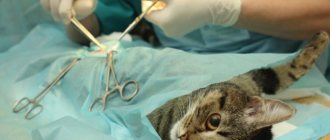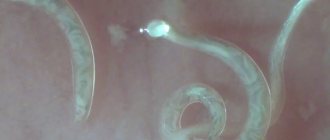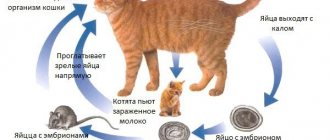Helminthiasis is a fairly popular disease of worms in the animal world, during which parasitic worms - helminths, as well as their larvae - settle in the internal environment of the affected animal's body. Humans, like cats, who have lived together since ancient times, are subject to helminthic infestations to the same extent.
Clinical manifestations of the disease stem from disruption and damage to the functioning of many organs. Therefore, animals need to be treated on time , since a sick four-legged friend suffers not only himself and requires the help of the owner, members of the family where the cat lives can also be affected.
In the article we will look at the most common types of parasites in animals, signs of the disease, and also - we will answer one of the most frequently asked questions - how to cure worms in a cat and what the parasites look like.
Ways of infecting cats with worms
Parasites constantly circulate in the environment; larvae and eggs are found in soil, water, dust, in any corner of the territory, regardless of its sanitary conditions. Signs of worms are detected in cats that never go outside; they “receive” helminths in utero or the larvae enter the house on shoes.
The risk of invasion increases with:
- the presence of raw foods (fish, meat) in the diet;
- skin parasites (ticks, fleas);
- contact with infected animals;
- free range.
A cat passes worms to its offspring in utero, so it is important to give deworming tablets for cats before mating.
Photo gallery
Photo 1. Anti-worm medication
Photo 2. One of the ways of infection with helminths
Photo 3. Types of helminths
Harm from worms
Worms in a domestic cat negatively affect its health, damaging internal organs. In severe cases, with extensive infection, deformities are possible, leading to death.
What is the harm from worms:
- Mechanical damage.
Injuries to the internal mucous membranes are caused by fixation devices - teeth, hooks, spikes. When parasites migrate, the integrity of organs and tissues is disrupted, and areas of bleeding are formed. Obstruction (blockage) of the intestines and large arteries by balls of worms is dangerous.
- Intoxication.
Signs of general poisoning of the body increase with the increase in the number of worms. Intoxication is caused by tissue breakdown products and the decomposition of dead helminths themselves.
- Complications from secondary infections.
Worms reduce the animal’s immunity, so viral and bacterial infections easily penetrate the body, complicating the course of helminthiasis. Worms contribute to the exacerbation of chronic pathologies; microtraumas on the mucous membranes become gateways for the penetration of bacteria.
Where are helminths located?
Symptoms of worms in cats depend on the location. In an animal's body, parasites can be found in any tissue, organ or circulatory system.
- Specific localization.
Parasites of certain species live in clearly defined places. Making a diagnosis with a specific localization is easier than with the “random” movement of worms in the body. Habitats: gastrointestinal tract, liver, biliary tract, heart, lungs, blood vessels, kidneys, bladder, eyes.
- Perverted (non-specific).
The parasite is located in an unusual location, causing atypical symptoms of the disease, which makes diagnosis difficult. Most often, perverted localization is observed in liver flukes and roundworms (Toxocara, Ascaris).
- Transit.
Eggs and larvae of helminths pass through the body without affecting it and without staying for a long time. They are accidentally found during the examination of feces, a complete examination of the animal. There are no clinical symptoms of worms inside the cat.
Symptoms of ectoparasites
The main sign of infection with ectoparasites is a skin reaction. It includes the following symptoms:
- redness;
- inflammation;
- ulcerations;
- suppuration;
- local or total hair loss;
- dandruff;
- severe itching.
Due to constant scratching, the animal's body quickly becomes covered with bloody crusts. Bacteria and other pathogenic organisms easily penetrate into the lesions, complicating the course of the underlying disease.
Types of worms in cats
Signs of helminthic infestation can be pronounced (vomiting, cough, chronic diarrhea) or latent, occurring with lethargy and apathy. Symptoms depend on the types of worms, divided by shape, method of feeding, and reproduction.
Roundworms
Roundworms are the most common inhabitants of the cat's body. They are white, slightly yellowish in color, up to 10 cm long, reminiscent of thin wire, or spaghetti with tapering at the ends. With a high degree of infestation, worms come from the throat (vomiting) or are found in feces during a routine examination. In kittens, roundworms cause an excessive appetite; visually the pet is very thin, but with a voluminous tummy. In adults, chronic diarrhea, anorexia, lethargy, and apathy are suspected of ascariasis.
In the human body they do not go through a full development cycle, but they reduce immunity and cause an allergic reaction.
Hookworms live in the intestines; larvae and adults feed on blood. Infection of an animal occurs in utero, through food, skin. They enter the human body through the skin, causing skin diseases.
In cats, hookworm infection causes bloody diarrhea, thirst, barking cough, anorexia and lethargy.
Toxocara are long, roundworms reaching 18 cm. Favorite localization sites are the esophagus, liver, gall bladder, and intestines. Kittens are infected in utero, through food; toxocara is transmitted to adult cats through the mouth. Parasitic infestation is accompanied by vomiting, severe exhaustion, and chronic diarrhea. For kittens, mass infection by sexually mature individuals leads to intestinal blockage and rupture.
Tapeworms (flatworms)
Tapeworms parasitize the small intestine, attaching to the walls with the help of the scolex (suction cups, chitinous hooks). A body composed of many segments in which larvae mature. As the segments mature, they break off, come out with feces, and the eggs infect the external environment.
- Cucumber tapeworm.
Difficult to hatch, feels comfortable in cats and humans (reaches up to 1.5 m). In the intestines, it attaches to the wall with the help of hooks, damaging the mucous membrane and feeding at the expense of the body. Carriers of tapeworm are lice eaters and fleas.
- Wide tape.
In a cat’s body it grows up to 1.5 m, in a person – up to 12 meters. This is the largest specimen of any tapeworm. The source of wide tapeworm is raw river fish and small freshwater crustaceans.
- Flukes.
Parasites that destroy the internal organs of cats and humans. They range in length from a few millimeters to 1.5 m. The worms are sucked in using “toothed” suction cups arranged in several rows. They destroy the liver, bladder, intestines, lungs, and are often found in the Eustachian tube and conjunctival sac. A cat becomes infected by eating raw freshwater fish.
- Liver fluke.
Affects the liver, pancreas, and gall bladder. Lungworms are introduced into a cat’s body when it accidentally ingests crustaceans and freshwater mollusks. Parasites provoke cysts in the lungs, gradually destroying the lung tissue. Dangerous for humans.
The smallest parasites are cestodes (tapeworms), reach a length from 5 mm to 1.5 m, the body is flat, chitinous hooks or suckers are located on the head. The body is segmented, eggs mature in each segment. The source of cestodes is rodents (mice, rats). The parasite is dangerous for humans; the disease ends in a malignant neoplasm of the liver with metastasis throughout the body. Cats can carry the infection within them for years without clinical signs of cestodosis.
Side effects of deworming
Improperly performed deworming can harm the kitten.
Unsuitable anthelmintics can cause side effects in your kitten:
- nausea, vomiting;
- foam at mouth;
- allergic reactions;
- dyspnea;
- problems with breathing and stool;
- sudden weight loss.
The most common adverse reaction is diarrhea. If it lasts no more than 38 hours, this is normal. This is how the pet’s body reacts to the active substances and accelerates the elimination of dead parasites. When side effects appear (nausea, vomiting, itching, muscle spasms, salivation), this indicates intolerance to the components of the composition. Then you need to change the anthelmintic.
In addition to side effects, improper deworming can lead to serious complications - anaphylactic shock, bleeding, sudden changes in pressure, breathing problems, and kidney function.
Worms: clinical signs
Does the cat have worms? The severity of symptoms depends on the type of helminth, its location, size, number of parasitic individuals, the age of the animal and its state of health.
Common symptoms of helminthic infestation include:
- depression, appetite distortion or anorexia;
- bad coat, heavy shedding;
- dried crusts in the corners of the eyes without inflammation;
- disruption of the gastrointestinal tract (constipation, diarrhea, vomiting);
- intestinal obstruction;
- swollen, barrel-shaped belly;
- anemia, a sharp decrease in immunity;
There may be blood in the stool, kittens are stunted, and convulsions may occur during intoxication. Whole mature worms, sometimes segments, and often fragments of cucumber tapeworm come out of the anus and “hang on the fur” are found in feces or vomit.
Danger to humans
There are helminthiases that can be transmitted from pets to humans:
- alveococcosis;
- diphyllobothriasis;
- dipylidosis;
- dirofilariasis;
- toxascariasis.
The main route by which helminths are transmitted to humans is through food and through contaminated hands. The above diseases lead to severe illness and even death. Therefore, deworming of domestic animals is also a primary measure to prevent human infection.
How to treat worms in cats?
Therapy consists of the destruction of adults and larvae, symptomatic treatment, and elimination of intoxication. Anti-worm medications are available in the form of a suspension, tablets (Milbemax), paste (Dirofen), and drops on the withers.
Cats are not given medications for humans; medications are purchased at a veterinary pharmacy after the doctor makes a diagnosis and gives the appropriate prescriptions.
Rules for giving deworming medications to cats:
- Once, in the morning on an empty stomach.
- Repeated appointment on 10-14 days.
- Together with deworming, external parasites (fleas, ticks, etc.) are destroyed.
- Mandatory provision of funds 10 days before vaccination, before mating.
- Do not give medications to kittens under 3 weeks of age, sick or weakened animals.
It is recommended that the cat owner and family members carry out preventive deworming; many parasites are dangerous to humans.
Folk remedies and prevention
Traditional remedies for deworming in cats have side effects, but folk remedies are not welcomed by veterinarians. This is explained by the lack of evidence of the therapeutic effect and increased activity of parasites. As a result, worms begin to migrate throughout the body, creating discomfort and increased trauma to internal organs.
Prevention at home consists of giving anthelmintic drugs to adults once every 3-4 months, with mandatory flea treatment. In cats under one year of age, the frequency of drug administration is associated with vaccination. Your veterinarian will tell you what to give cats for worms! Feeding raw meat and fish is not prohibited, but with this type of feeding, worm prevention is mandatory.
How to detect parasites?
As soon as a pet owner suspects that his pet has worms, he should immediately take him to a veterinarian.
To confirm or refute the diagnosis, you will need to undergo diagnostics.
The specialist conducts a test, checking the cat's feces for the presence of worms. It is worth saying that you may not be able to carry out the analysis once and calm down. If the parasites entered very recently, the result will be negative. Therefore, you will need to undergo such diagnostics several more times . If the diagnosis is confirmed, the doctor will prescribe treatment. Therapy should be started immediately and can be treated at home.











